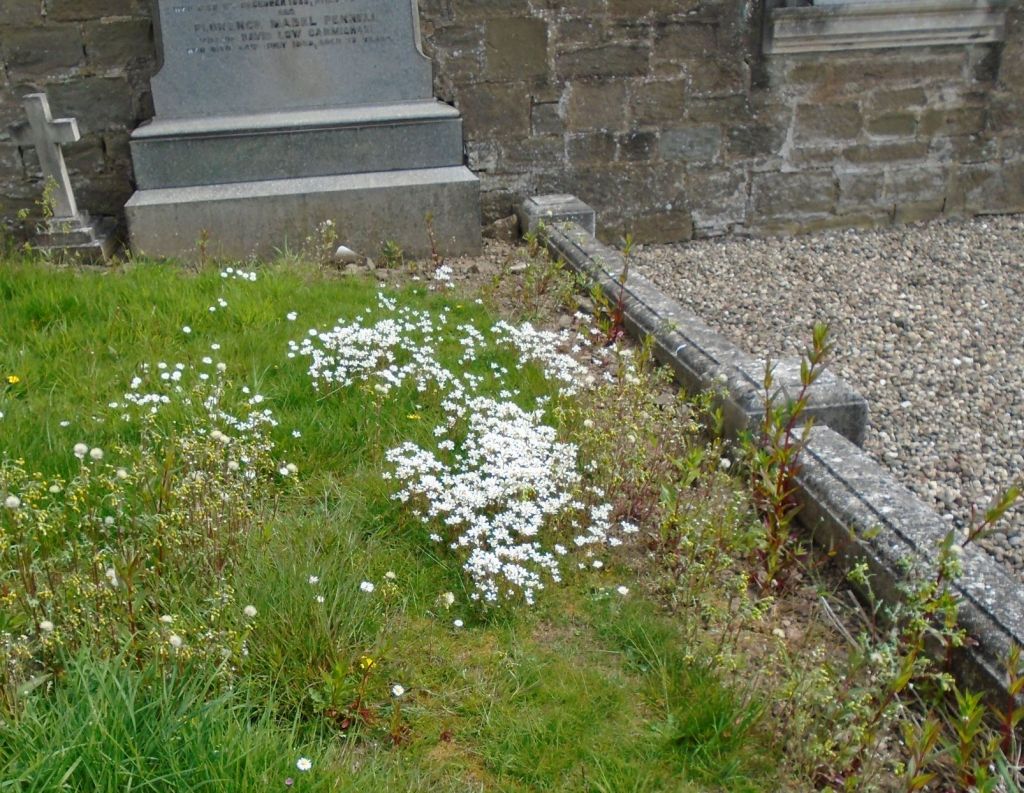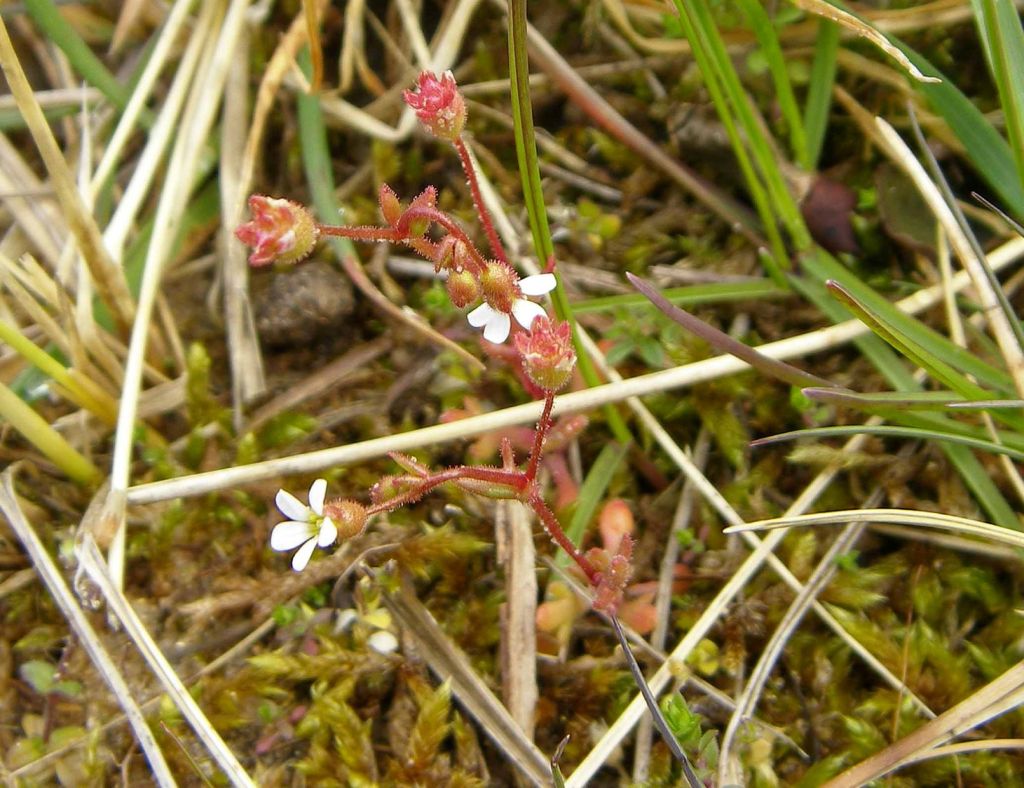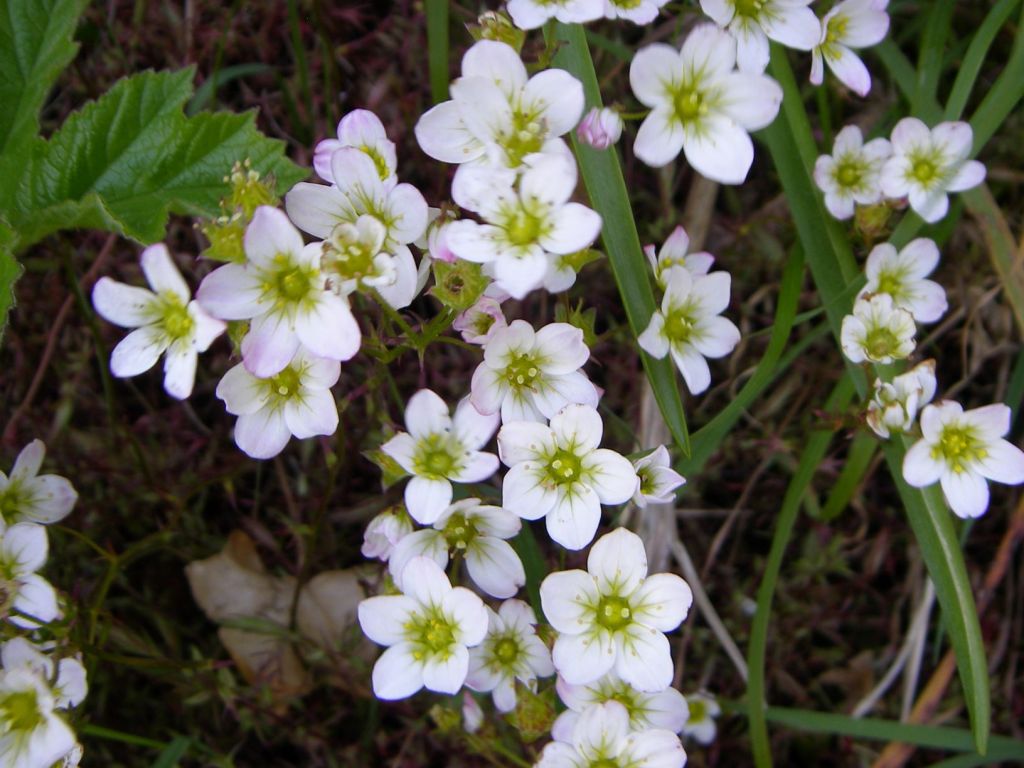Saxifrages have a special appeal for some, and they often have their own particular beauty. We only have relatively few species in Scotland and they are often thought of as being mountain plants. However, some are found at low levels and may on occasion come near to the shore. I will describe five native species which may be found near sea level. A few garden escapes also sometimes survive at lower levels.
Saxifraga granulata (Meadow Saxifrage). This attractive plant has white relatively large white flowers with 5 petals longer than the calyx. Its 5 to 7 lobed rounded leaves are in a basal rosette. The leaves are often long-stalked but this may be modified by grass cutting. Although it produces viable seed, dispersal is mainly from the red basal bulbils.
Meadow Saxifrage tends to favour base-rich or neutral dry grassland. In Scotland it has an eastern distribution, often near the coast. It flowers in the spring and early summer, dying back later in the year.
This species is widespread in England, although there has been some decline, but is less frequent in Scotland. Meadow Saxifrage is frequent in Northern and Central Europe. Although native, some cultivated varieties also sometimes escape.
I am familiar with it from Dundee where it flourishes in the Broughty Ferry Local Nature Reserve and the nearby coast. I have recently found it growing in the Western and Barnhill cemeteries in Dundee in association with Luzula campestris. In Easter Ross it is to be seen in the old graveyards at Tain and Portmahomack, although often diminished by grass cutting. This saxifrage also grows close to the shore on the Black Isle and Fearn Peninsula.
Saxifraga tridactylites (Rue-leaved Saxifrage). This tiny hairy winter annual is often overlooked, as it may flower early in the year, often in April and May. It leaves may be lobed with long pedicels and can often be detected because of their red colouration. It has beautiful star like small white flowers.
It may be the most widespread saxifrage in Europe. It tends to grow on open bare ground and can often be seen in man-made habitats. Rue-leaved Saxifrage is common in England, where I have seen it in Yorkshire limestone area. It is less frequent in Scotland, although there have been more recent reports from urban areas of Glasgow. Most other Scottish records are from near the coast.
In Scotland I first saw it in Dornoch on the dune camp site. In Easter Ross the Nigg dunes are its only persistent known site where it often appears on ruined buildings or bare ground. I have also seen it on Morrich More and there is also a record from the nearby coast.
Saxifraga hypnoides (Mossy Saxifrage). This is usually a mountain plant, but in northern Scotland sometimes descends to sea level. It is classified as vulnerable in the Red Data Book. Its starry white flowers are in an upright loose panicle of 2 to 7 flowers which have a yellow centre. Its leaves are fine and linear with a hair point and form a mat. It usually flowers between May and June. Mossy Saxifrage usually prefers a base-rich habitat.
In Europe Mossy Saxifrage is confined to the North and West, being less common than some of the other saxifrages. It is quite frequent in the Scottish mountains and also occurs in some upland parts of England.
It is far from being a usual coastal plant, but by the Mound in East Sutherland it grows on rock faces near the sea. On the Black Isle there is a healthy population close to the shore near Hillockhead, quite close to coastal populations of Saxifraga granulata.
It is also sometimes cultivated and cultivars are to be found on wild land in a few places such as by Ardgay on the Dornoch Firth.
Saxifraga oppositifolia (Purple saxifrage) This is a mountain plant that flowers early in the year between March and May, often being the first plant to flower in the high hills. It is our only purple flowered saxifrage and usually has opposite leaves. It tends to be prostrate, growing in dense mats, often favouring base-rich habitats.

It only reaches sea level on the north coast of Scotland in a few places. Purple Saxifrage has a wide northern distribution, in arctic areas as well as some mountains, both in Europe and North America.
Saxifraga aizoides (Yellow Mountain Saxifrage). This predominantly mountain plant was described in a previous blog about mountain species washed down in river gravel at the foot of the hills. (“you don’t always need to climb that mountain”). It has characteristic toothed green leaves with clusters of 2 to 14 bright yellow flowers. The yellow flowers often have orange spots.

It is an arctic-alpine plant that also grows in Greenland and Canada. On the north coast of Scotland, it grows near sea level by Invernaver and Bettyhill.
See below for a comparison of the global distributions of all five species. All are confined to the Northern Hemisphere and there is a strong contrast between the first three and the last two.

References:
Butler K. (2009). Wild Plants of the North highlands of Scotland. Berlinn, Edinburgh.
Preston C. D., Pearman d. A. and Dines T. D. (2002). New atlas of the British and Irish Flora (2002). Oxford University Press.
Webb D. G. and Gornall R. J. (1989). Saxifrages of Europe. Christopher Helm, Kent.
Brian Ballinger






My son was hiking in the Isle of Skye this August just past. He took a photo of a beautiful dew-dappled leaf. I am trying to identify it. The search engines keep hitting on saxifrage. But I haven’t seen another photo that looks like it.
If I were to send the photo, could you please help me identify it?
LikeLike